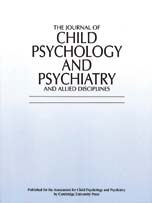Crossref Citations
This article has been cited by the following publications. This list is generated based on data provided by
Crossref.
Gerrits, E.
de Jong, J.
and
Rispens, J.E.
1999.
Handboek Stem– Spraak– Taalpathologie.
p.
1632.
Heath, Steve M.
and
Hogben, John H.
2000.
Auditory temporal processing, phonological awareness, and oral language ability in prereaders: Can we identify children at risk for reading disability more accurately?.
The Australian Educational and Developmental Psychologist,
Vol. 17,
Issue. 1,
p.
32.
McArthur, G.M.
and
Bishop, D.V.M.
2001.
Auditory perceptual processing in people with reading and oral language impairments: current issues and recommendations.
Dyslexia,
Vol. 7,
Issue. 3,
p.
150.
McArthur, G. M.
and
Hogben, J. H.
2001.
Auditory backward recognition masking in children with a specific language impairment and children with a specific reading disability.
The Journal of the Acoustical Society of America,
Vol. 109,
Issue. 3,
p.
1092.
Catts, Hugh W.
Fey, Marc E.
Tomblin, J. Bruce
and
Zhang, Xuyang
2002.
A Longitudinal Investigation of Reading Outcomes in Children With Language Impairments.
Journal of Speech, Language, and Hearing Research,
Vol. 45,
Issue. 6,
p.
1142.
Viholainen, Helena
PhD, Timo Ahonen
PhD, Marja Cantell
Lyytinen, Paula
and
Lyytinen, Heikki
2002.
Development of early motor skills and language in children at risk for familial dyslexia.
Developmental Medicine & Child Neurology,
Vol. 44,
Issue. 11,
p.
761.
Rosen, Stuart
2003.
Auditory processing in dyslexia and specific language impairment: is there a deficit? What is its nature? Does it explain anything?.
Journal of Phonetics,
Vol. 31,
Issue. 3-4,
p.
509.
Flax, Judy F.
Realpe-Bonilla, Teresa
Hirsch, Linda S.
Brzustowicz, Linda M.
Bartlett, Christopher W.
and
Tallal, Paula
2003.
Specific Language Impairment in Families.
Journal of Speech, Language, and Hearing Research,
Vol. 46,
Issue. 3,
p.
530.
Facoetti, Andrea
Luisa Lorusso, Maria
Paganoni, Pierluigi
Umiltà, Carlo
and
Gastone Mascetti, Gian
2003.
The role of visuospatial attention in developmental dyslexia: evidence from a rehabilitation study.
Cognitive Brain Research,
Vol. 15,
Issue. 2,
p.
154.
Griffiths, Yvonne M.
Hill, Nicholas I.
Bailey, Peter J.
and
Snowling, Margaret J.
2003.
Auditory Temporal Order Discrimination and Backward Recognition Masking in Adults With Dyslexia.
Journal of Speech, Language, and Hearing Research,
Vol. 46,
Issue. 6,
p.
1352.
Tallal, Paula
2004.
Improving language and literacy is a matter of time.
Nature Reviews Neuroscience,
Vol. 5,
Issue. 9,
p.
721.
Ben-Yehudah, Gal
Banai, Karen
and
Ahissar, Merav
2004.
Patterns of deficit in auditory temporal processing among dyslexic adults.
NeuroReport,
Vol. 15,
Issue. 4,
p.
627.
Hoskyn, Maureen
2004.
Learning About Learning Disabilities.
p.
93.
McArthur, G. M.
and
Bishop, D. V. M.
2004.
Frequency Discrimination Deficits in People With Specific Language Impairment.
Journal of Speech, Language, and Hearing Research,
Vol. 47,
Issue. 3,
p.
527.
Nation, Kate
Clarke, Paula
Marshall, Catherine M.
and
Durand, Marianne
2004.
Hidden Language Impairments in Children.
Journal of Speech, Language, and Hearing Research,
Vol. 47,
Issue. 1,
p.
199.
Ullman, Michael T
2004.
Contributions of memory circuits to language: the declarative/procedural model.
Cognition,
Vol. 92,
Issue. 1-2,
p.
231.
Heath, Steve M.
and
Hogben, John H.
2004.
Cost-Effective Prediction of Reading Difficulties.
Journal of Speech, Language, and Hearing Research,
Vol. 47,
Issue. 4,
p.
751.
Hugdahl, Kenneth
Gundersen, Hilde
Brekke, Cecilie
Thomsen, Tormod
Rimol, Lars Morten
Ersland, Lars
and
Niemi, Jussi
2004.
fMRI Brain Activation in a Finnish Family With Specific Language Impairment Compared With a Normal Control Group.
Journal of Speech, Language, and Hearing Research,
Vol. 47,
Issue. 1,
p.
162.
Dockrell, Julie E.
and
Lindsay, Geoff
2004.
Handbook of Children’s Literacy.
p.
403.
Roach, Neil W
Edwards, Veronica T
and
Hogben, John H
2004.
The Tale is in the Tail: An Alternative Hypothesis for Psychophysical Performance Variability in Dyslexia.
Perception,
Vol. 33,
Issue. 7,
p.
817.


